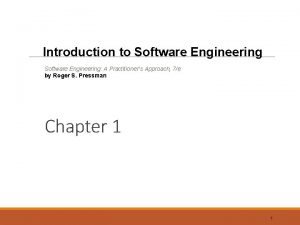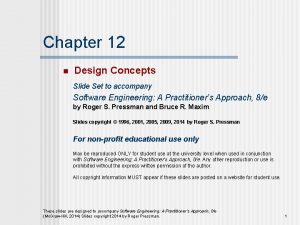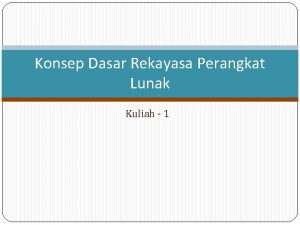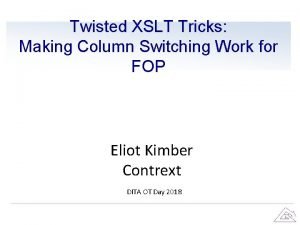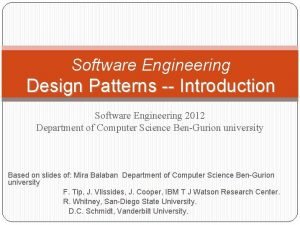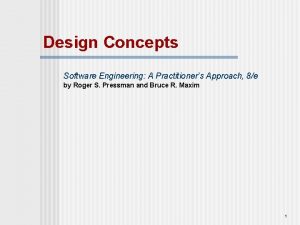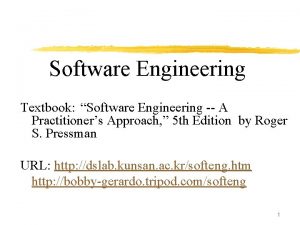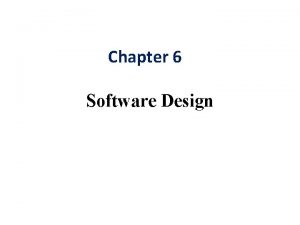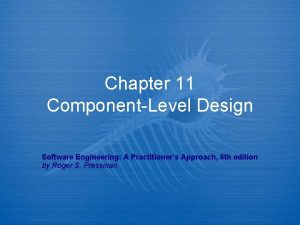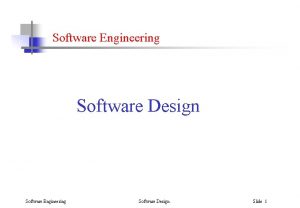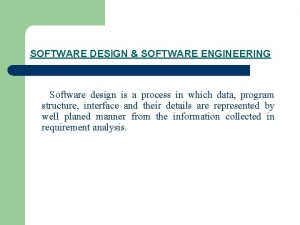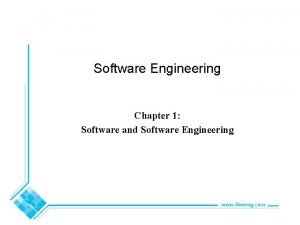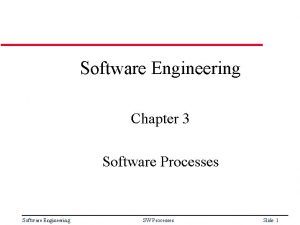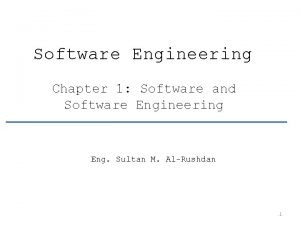Chapter 8 Design Concepts Software Engineering A Practitioners




















![Refactoring Fowler [FOW 99] defines refactoring in the following manner: "Refactoring is the process Refactoring Fowler [FOW 99] defines refactoring in the following manner: "Refactoring is the process](https://slidetodoc.com/presentation_image_h2/bcbae383b162e4fde459da0dc4fdba30/image-21.jpg)




- Slides: 25

Chapter 8 Design Concepts Software Engineering: A Practitioner’s Approach, 7 th edition by Roger S. Pressman Created based on the Chapter 9 of 6 th by Mirian 1

Analysis Design 2

Design Principles • • • The design process should not suffer from ‘tunnel vision. ’ The design should be traceable to the analysis model. The design should not reinvent the wheel. The design should “minimize the intellectual distance” [DAV 95] between the software and the problem as it exists in the real world. The design should exhibit uniformity and integration. The design should be structured to accommodate change. The design should be structured to degrade gently, even when aberrant data, events, or operating conditions are encountered. Design is not coding, coding is not design. The design should be assessed for quality as it is being created, not after the fact. The design should be reviewed to minimize conceptual (semantic) errors. From Davis [DAV 95] 3

Design and Quality • the design must implement all of the explicit requirements contained in the analysis model, and it must accommodate all of the implicit requirements desired by the customer. • the design must be a readable, understandable guide for those who generate code and for those who test and subsequently support the software. • the design should provide a complete picture of the software, addressing the data, functional, and behavioral domains from an implementation perspective. 4

Quality Guidelines(1/2) • A design should exhibit an architecture that • (1) has been created using recognizable architectural styles or patterns, • (2) is composed of components that exhibit good design characteristics and • (3) can be implemented in an evolutionary fashion • For smaller systems, design can sometimes be developed linearly. • A design should be modular; that is, the software should be logically partitioned into elements or subsystems • A design should contain distinct representations of data, architecture, interfaces, and components. 5

Quality Guidelines(2/2) • A design should lead to data structures that are appropriate for the classes to be implemented and are drawn from recognizable data patterns. • A design should lead to components that exhibit independent functional characteristics. • A design should lead to interfaces that reduce the complexity of connections between components and with the external environment. • A design should be derived using a repeatable method that is driven by information obtained during software requirements analysis. • A design should be represented using a notation that effectively communicates its meaning. 6

Design Concepts abstraction — data, procedure, control architecture — the overall structure of the software patterns — “conveys the essence” of a proven design solution Separation of concerns — “divide and conquer” modularity — compartmentalization of data and function information hiding — controlled interfaces functional independence — high cohesion and low coupling refinement — elaboration of detail for all abstractions Aspects — some concerns which span entire system refactoring — improve design without effecting behavior 7

Abstraction et al. Abstraction process – extracting essential details entity – a model or focused representation Information hiding the suppression of inessential information Encapsulation process – enclosing items in a container entity – enclosure that holds the items 8

Data Abstraction door manufacturer model number type swing direction inserts lights type number weight opening mechanism implemented as a data structure 9

Procedural Abstraction open details of enter algorithm implemented with a "knowledge" of the object that is associated with enter 10

Architecture “The overall structure of the software and the ways in which that structure provides conceptual integrity for a system. ” [SHA 95 a] Structural properties. This aspect of the architectural design representation defines the components of a system (e. g. , modules, objects, filters) and the manner in which those components are packaged and interact with one another. For example, objects are packaged to encapsulate both data and the processing that manipulates the data and interact via the invocation of methods Extra-functional properties. The architectural design description should address how the design architecture achieves requirements for performance, capacity, reliability, security, adaptability, and other system characteristics. Families of related systems. The architectural design should draw upon repeatable patterns that are commonly encountered in the design of families of similar systems. In essence, the design should have the ability to reuse architectural building blocks. 11

Patterns A pattern for software architecture describes a particular recurring design problem that arises in specific design contexts, and presents a well-proven generic scheme for its solution. The solution scheme is specified by describing its constituent components, their responsibilities and relationships, and the ways in which they collaborate. (Chapter 12) 12

Separation of Concerns Any Complex problem can be more easily handled if it is subdivided into pieces that can be solved independently. A Concern is a feature or behavior that is specified as part of the requirements model. 13

Modular Design 14

Modularity: Trade-offs What is the "right" number of modules for a specific software design? module development cost of software module integration cost optimal number of modules 15

Information Hiding module controlled interface • algorithm • data structure • details of external interface • resource allocation policy clients "secret" a specific design decision 16

Why Information Hiding? • • • reduces the likelihood of “side effects” limits the global impact of local design decisions emphasizes communication through controlled interfaces discourages the use of global data leads to encapsulation—an attribute of high quality design • results in higher quality software 17

Functional Independence 18

Stepwise Refinement open walk to door; reach for knob; open door; walk through; close door. repeat until door opens turn knob clockwise; if knob doesn't turn, then take key out; find correct key; insert in lock; endif pull/push door move out of way; end repeat 19

Aspects Ideally a requirement model can be organized in a way that allows you to isolate each concern so that it can be considered independently. But some of these concerns span the entire system. 20
![Refactoring Fowler FOW 99 defines refactoring in the following manner Refactoring is the process Refactoring Fowler [FOW 99] defines refactoring in the following manner: "Refactoring is the process](https://slidetodoc.com/presentation_image_h2/bcbae383b162e4fde459da0dc4fdba30/image-21.jpg)
Refactoring Fowler [FOW 99] defines refactoring in the following manner: "Refactoring is the process of changing a software system in such a way that it does not alter the external behavior of the code [design] yet improves its internal structure. ” When software is refactored, the existing design is examined for • • • redundancy unused design elements inefficient or unnecessary algorithms poorly constructed or inappropriate data structures or any other design failure that can be corrected to yield a better design. 21

OO Design Concepts: Design Classes • User interface classes – define abstractions necessary for HCI. • Business domain classes – refinements of analysis classes. • Process classes – lower-level business abstractions that manage business domain classes. • Persistent classes – data stores (databases) that persist beyond execution of the software. • System classes – management and control functions that enable the system to operate and communicate within its computing environment and 22 with the outside world.

Well-formed Design Class • Complete and sufficient – class should be a complete and sufficient encapsulation of reasonable attributes and methods. • Primitiveness – each method should be focused on one thing. • High cohesion – class should be focused on one kind of thing. • Low coupling – collaboration should be kept to an acceptable minimum. 23

The Design Model 24

Design Model Elements Data elements Architectural level databases and files Component level data structures Architectural elements An architectural model is derived from: Application domain Analysis model Available styles and patterns Interface elements There are three parts to the interface design element: The user interface (UI) Interfaces to external systems Interfaces to components within the application Component elements Deployment elements 25
 Software engineering a practitioners approach
Software engineering a practitioners approach Design concepts in software engineering
Design concepts in software engineering Design concepts in software engineering
Design concepts in software engineering Real time software design in software engineering
Real time software design in software engineering Design principles in software engineering
Design principles in software engineering Konsep rekayasa perangkat lunak
Konsep rekayasa perangkat lunak What is system in software engineering
What is system in software engineering Forward engineering and reverse engineering
Forward engineering and reverse engineering Software maintenance process models ppt
Software maintenance process models ppt Who invented software engineering
Who invented software engineering What is software metrics in software engineering
What is software metrics in software engineering Software engineering crisis
Software engineering crisis What is software measurement
What is software measurement National association of patent practitioners
National association of patent practitioners Medical practitioners assurance framework
Medical practitioners assurance framework Theatre practitioner meaning
Theatre practitioner meaning Grade r progress report
Grade r progress report Association of independent insolvency practitioners
Association of independent insolvency practitioners Kimber dita for practitioners volume 1 (epub|pdf|mobi)
Kimber dita for practitioners volume 1 (epub|pdf|mobi) Tax practitioners association indore
Tax practitioners association indore Curbside management practitioners guide
Curbside management practitioners guide Unregistered health practitioners
Unregistered health practitioners Social business practitioners
Social business practitioners Australian college of nurse practitioners
Australian college of nurse practitioners User interface in software engineering
User interface in software engineering Design patterns software engineering
Design patterns software engineering
